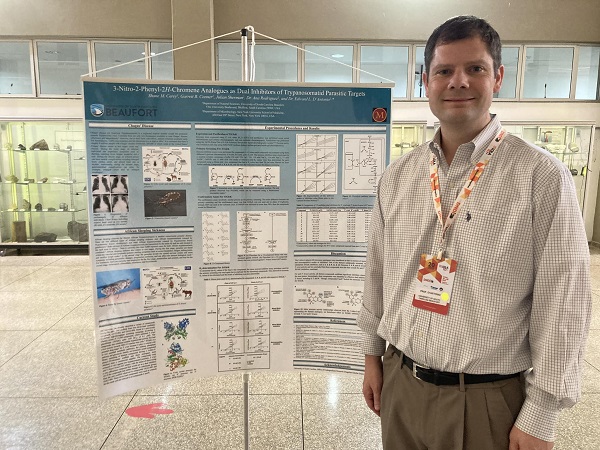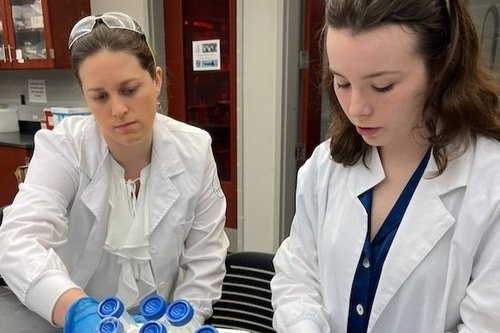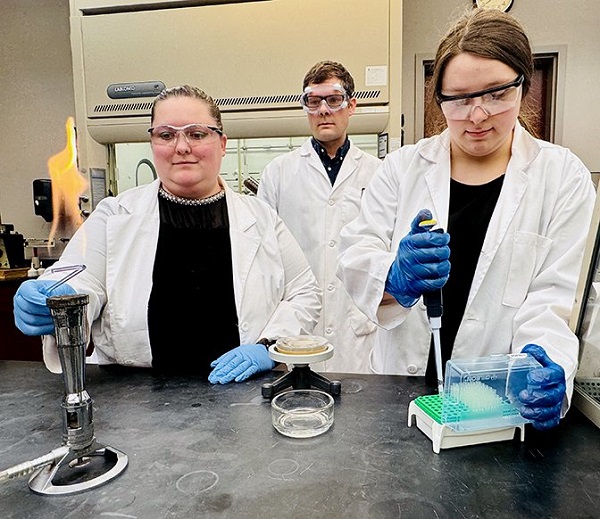Professor D'Antonio and his Undergraduate Researchers Seek Advances Toward Chagas' Disease
 Professor Edward D’Antonio presented a poster on Chagas’ disease at the 2023 “Drugs
for Neglected Diseases initiative - DNDi LOLA10” conference in Campinas, Brazil.
Professor Edward D’Antonio presented a poster on Chagas’ disease at the 2023 “Drugs
for Neglected Diseases initiative - DNDi LOLA10” conference in Campinas, Brazil.About seven million people, mostly in Latin America, have Chagas’ disease. Now, a faculty-student research team at the University of South Carolina Beaufort might have discovered a new way to beat the illness.
“Chagas’ disease is a neglected tropical disease requiring an overhaul of the current therapeutic medicinal options,” said research project leader Edward L. D'Antonio, PhD, Professor of Biochemistry and Structural Biology. “The goal of our research is to eventually discover a therapeutic having a good relative efficacy that lacks harsh side effects.”
Chagas’ disease is considered a neglected tropical disease because it is rarely addressed by global health programs and funding agencies. It is caused by a unicellular parasite — Trypanosoma cruzi — commonly transmitted by the bite from the blood-sucking triatomine bug, often referred to as the kissing bug — and kissing bugs are found in the South Carolina Lowcountry.
In the initial stage of infection, the symptoms of Chagas’ disease range from nothing to fever, headache, muscle pain, difficulty in breathing, and abdominal or chest pain. If untreated, the disease can cause cardiac and digestive disorders, including enlarged heart and colon. In later years, it can result in the inflammation of key digestive tract organs and the heart, heart failure, and sudden death. Between 5% to 10% of those infected with Chagas’ disease will die from it.
 Anna Husted and Lindsey Baker are two of the USCB students conducting Chagas’ disease
research under the supervision of Professor Edward L. D'Antonio.
Anna Husted and Lindsey Baker are two of the USCB students conducting Chagas’ disease
research under the supervision of Professor Edward L. D'Antonio. To survive and reproduce, the T. cruzi parasite that causes Chagas’ disease needs to absorb nutrition from its host’s cells. Glucose is one supplement the parasite needs. D’Antonio and his USCB team of student researchers have identified three metabolic pathways within T. cruzi that utilize glucose. Blocking glucose from these three pathways effectively will starve and kill the parasite. This strategy is the team’s focus for stopping Chagas’ disease in its tracks.
D’Antonio and his students screened around 100 compounds to identify the successful inhibitor that is key to blocking the three pathways. For the next phase of their research, they will directly test and analyze the inhibitor’s effectiveness.
“This contribution is significant because it is expected to lead to a new therapeutic candidate that will surpass the effectiveness of benznidazole and nifurtimox, the current treatments for Chagas’ disease,” D’Antonio said.
Benznidazole and nifurtimox are prescribed for 60 days during the acute stage of Chagas’ disease when inflammatory symptoms of the digestive tract organs or the heart are not present. However, because the side effects can be harsh, including stinging pain in the fingertips, nausea and vomiting, many Chagas’ disease patients stop taking their prescriptions.
USCB biology students Lindsey Baker, Carson Frey, Anna Husted and Destiny O’Neill are running the assays (tests) on the glucose inhibitors. They’re using a small screening approach with a microplate reader in the laboratory. Observing how the many versions of a key compound scaffold would react during an assay is the very first step in early-stage drug discovery.
 USCB biology majors Carson Frey and Destiny O’Neill at work in the D’Antonio laboratory
running assays.
USCB biology majors Carson Frey and Destiny O’Neill at work in the D’Antonio laboratory
running assays. “Some compounds will then hopefully move on to the next trial of experimental testing and eventually may be chosen to help people in need. It's a lot of hard work and time that I think will leave no stone unturned,” Frey said.